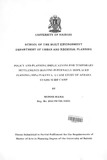| dc.contributor.author | Murugi, Maina | |
| dc.date.accessioned | 2013-02-20T12:40:39Z | |
| dc.date.issued | 2008 | |
| dc.identifier.uri | http://erepository.uonbi.ac.ke:8080/xmlui/handle/123456789/10479 | |
| dc.description.abstract | Internally Displaced Persons (IDPs) are increasing becoming a
challenge to Kenya. Whether displaced by conflict, disaster or
development initiatives, the IDP population is often left to grapple with
no basic needs and destroyed livelihoods. The contribution that urban
planning can make to elevate, prevent or respond to the needs of the
displaced is the gap this research work sought to fill.
This research work recognizes that internally displaced persons (IDPs)
exist even in countries that are considered peaceful, such as Kenya.
The research work also reveals that IDPs existed even before the 2007
post-election violence. The post-election violence only served to bring
to prominence the problem facing IDPs which existed from many
years.
The study objectives were to a. Identify immediate needs of displaced
populations and their spatial implications. b. Assess the type and
adequacy of response services required by displaced populations. c)
Propose a policy and planning framework.
The main research methods used include a. A desk review of existing
literature. b. Focus Group Discussions c. Face-to- face interviews. d.
Observation. e. Photography. Data collected was analysed through
spread sheets tabulation.
The main findings indicate that a. Kenya has no policy addressing
IDPs b. Food, shelter, education, safety and security, and water and
sanitation are some of the immediate needs facing IDPs, and they also
have spatial implications. These needs are also often not met
adequately. Non-governmental agencies at national and national levels
were largely involved in response operations. Government of Kenya at
the local level also supported the agencies with technical officers such
as social workers.
This research work goes ahead to propose measures that should be
put in place to address the spatial needs of displaced populations
through plans and implementation approaches. Such include the
setting aside of land to host displaced populations, involvement of
local authorities and practitioners in response initiatives involving
displaced populations and sectoral minimum standards that need to
be applied. Also recommended is the development of a policy on IDPs. | en |
| dc.description.sponsorship | University of Nairobi | en |
| dc.language.iso | en | en |
| dc.publisher | University of Nairobi | en |
| dc.subject | Internally Displaced Persons ( IDPs) - - KENYA | en |
| dc.title | Policy and Planning Implications for Temporary Settlements Hosting Internally Displaced Persons ( IDPs) In Kenya: A Case Study of Afraha Stadium IDP Camp | en |
| dc.title.alternative | Thesis Submitted in Partial Fulfilment for the Requirements of Master of Arts in Planning Degree of the University of Nairobi | en |
| dc.type | Thesis | en |
| local.publisher | School of the Built Environment Department of Urban and Regional Planning | en |

